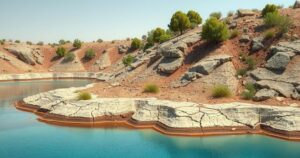Study Confirms Iran Earthquake Was Not Caused by Nuclear Test

A new study confirms that a 4.5 magnitude earthquake in Iran was a natural occurrence, not a result of a nuclear test, despite widespread misinformation circulating on social media and news reports. Researchers emphasized the importance of proper scientific interpretation during geopolitical tensions, highlighting the need for swift communication to counteract misrepresentation of data.
A recent study has clarified that a significant earthquake in Iran, which occurred on October 5, 2024, was not a consequence of a nuclear test, dispelling widespread rumors. The 4.5 magnitude quake took place near Semnan, a seismically active region, coinciding with rising tensions in the Middle East. Researchers from Johns Hopkins University indicated that misinformation regarding the earthquake proliferated rapidly on social media, leading to unfounded claims of nuclear testing.
Lead researcher Dr. Benjamin Fernando highlighted that there was a substantial campaign of miscommunication concerning the earthquake. Extensive analysis of seismic signals confirmed that the tremor was attributed to natural geophysical events rather than human-made occurrences like a nuclear test. Dr. Fernando emphasized the importance of accurate scientific interpretation, particularly during geopolitical tensions, stating that geophysical data can provide crucial insights amidst crises.
The research utilized data from public seismic monitoring stations, revealing that the quake resulted from a geological fault caused by the collision of the Arabian and Eurasian tectonic plates, characteristic of the region’s geological activity. Dr. Fernando noted that the seismic waves from the earthquake shared distinct characteristics, separating them from the signatures produced by nuclear explosions. Historical data showed similar earthquakes in the area previously unrelated to nuclear tests.
Despite the clear scientific evidence indicating that the earthquake was natural, narratives claiming it was due to a nuclear test emerged on social media mere minutes after the event. Researchers documented that the initial reporting misinterpreted seismic data, leading to further propagation of falsehoods. The misinformation waves were compounded by conspiracy theories that erroneously linked the Iranian earthquake with other seismic activities elsewhere.
The study identified connections between the viral posts promoting the nuclear testing theory and accounts associated with disinformation efforts from foreign entities. The false narrative rapidly transitioned from social platforms to mainstream media coverage worldwide, highlighting the importance of timely fact-checking by scientific communities. The proliferation of misleading reports particularly surged in Indian media, which frequently cited each other and the inaccurate seismic data.
Researchers proposed enhancing collaboration among seismologists worldwide to better counteract the spread of misinformation by issuing prompt and detailed reports. Co-author Dr. Saman Karimi underscored the need for scientific institutions to work closely with social media platforms, suggesting that partnerships could significantly diminish undesired narratives and promote accurate information dissemination. Such proactive measures may aid in safeguarding scientific integrity amidst global conflict.
This article discusses a study that corrects misconceptions surrounding an earthquake in Iran, clarifying it as a natural occurrence rather than a nuclear test amidst rising geopolitical tensions. The misinformation gained traction on social media and mainstream news, prompting concerns from seismologists and the scientific community. Understanding the geological context of this event is crucial given its implications for international relations and the misrepresentation of scientific data during crises.
In summary, the recent research has decisively shown that the earthquake in Iran was a natural seismic event, countering erroneous claims of nuclear activity. The dissemination of misinformation highlights the urgent need for timely communication from scientific authorities and increased collaboration to uphold the integrity of scientific interpretation during geopolitical conflicts. Addressing false narratives is vital in today’s information-rich environment.
Original Source: www.thedigitalcourier.com






